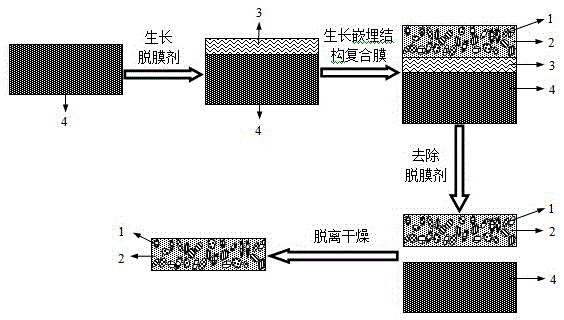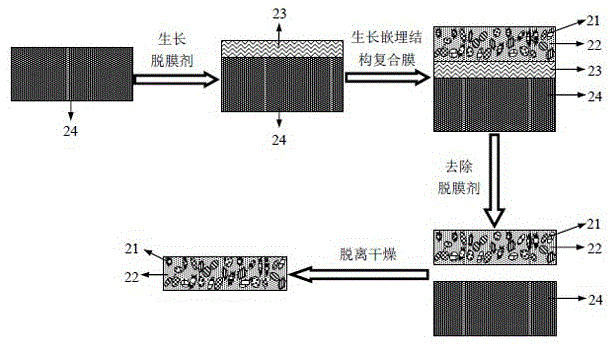Self-supporting physical unclonable key and preparation method thereof
A self-supporting, physical technology, applied in the fields of identity authentication and anti-counterfeiting, quantum key distribution, and quantum authentication, it can solve problems such as poor compatibility, and achieve the effects of low cost, high reliability, and high stability
- Summary
- Abstract
- Description
- Claims
- Application Information
AI Technical Summary
Problems solved by technology
Method used
Image
Examples
preparation example Construction
[0038] Such as figure 2 As shown, a method for preparing a self-supporting physical unclonable key comprises the following steps:
[0039] First, a layer of release agent is grown on the substrate.
[0040] Secondly, a composite film formed by embedding disordered micro-nano particles in a transparent medium is grown on the release agent layer.
[0041] Again, use a solvent to dissolve the release agent. If a soluble substrate is used, the substrate can also be dissolved directly.
[0042] Finally, the composite film in which the disordered micro-nano particles separated from the solvent are embedded in a transparent medium is taken out and dried to obtain a self-supporting physical unclonable key.
[0043] The resulting self-supporting physically unclonable key, such as figure 1As shown, it includes a number of disordered micro-nano particles 11 and a transparent medium 12, and a number of disordered micro-nano particles 11 are embedded in the transparent medium 12 to fo...
Embodiment 1
[0048] Such as image 3 As shown, the preparation method of this self-supporting physical unclonable key is as follows:
[0049] First, grow a layer of potassium chloride (KCl) with a thickness of 10 μm on a quartz glass substrate 24 with a thickness of 1 mm as a release agent 23;
[0050] Then, a sample of a composite film formed by growing TiO2 and ZnO disordered micro-nano particles 21 embedded in a transparent medium 22 on the KCl release agent 23 layer was obtained. The specific method is: mix TiO2 and ZnO micro-nano particles with a particle size distribution of 50-2000nm and an average particle size of 200nm into the UV-curable adhesive liquid at a volume fraction of 1:1, perform ultrasonic stirring and dispersion, and then grow by spin coating. On the 23rd layer of KCl release agent, the thickness is 20 μm;
[0051] Secondly, put the sample under ultraviolet light for irradiation curing;
[0052] Again, put the cured sample into deionized water to dissolve the KCl r...
Embodiment 2
[0055] Such as Figure 4 As shown, the preparation method of this self-supporting physical unclonable key is as follows:
[0056] First, spin-coat a layer of AZ4620 photoresist with a thickness of 6 μm on a silicon wafer substrate 34 with a thickness of 300 μm as a release agent 33;
[0057] Then, spray a layer of BaTiO3 disordered micro-nano particles 31 with a particle size distribution of 100-6000 nm and an average particle size of 300 nm on the photoresist release agent 33 layer, with a thickness of 20 μm to form a porous structure;
[0058] Secondly, a 10 μm-thick AlN transparent medium 32 is grown on the BaTiO3 disordered micro-nano porous layer by MOCVD method to fill the inside of the hole and protect the surface of the porous structure, so that a compound layer grown on the photoresist release agent 33 layer is obtained. film samples;
[0059] Again, put the sample into acetone to dissolve the photoresist stripper 33;
[0060] Finally, the composite film of BaTiO3 ...
PUM
 Login to View More
Login to View More Abstract
Description
Claims
Application Information
 Login to View More
Login to View More - R&D
- Intellectual Property
- Life Sciences
- Materials
- Tech Scout
- Unparalleled Data Quality
- Higher Quality Content
- 60% Fewer Hallucinations
Browse by: Latest US Patents, China's latest patents, Technical Efficacy Thesaurus, Application Domain, Technology Topic, Popular Technical Reports.
© 2025 PatSnap. All rights reserved.Legal|Privacy policy|Modern Slavery Act Transparency Statement|Sitemap|About US| Contact US: help@patsnap.com



